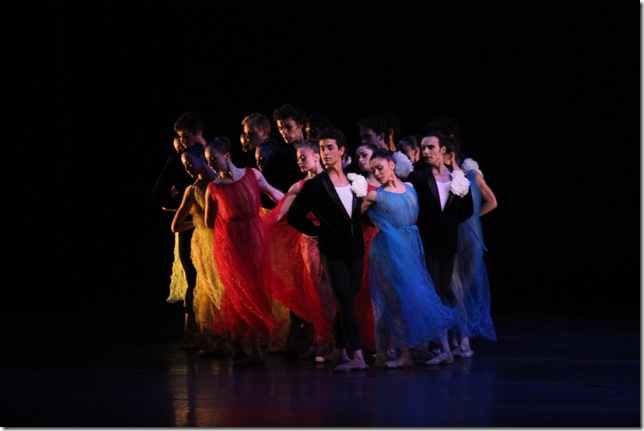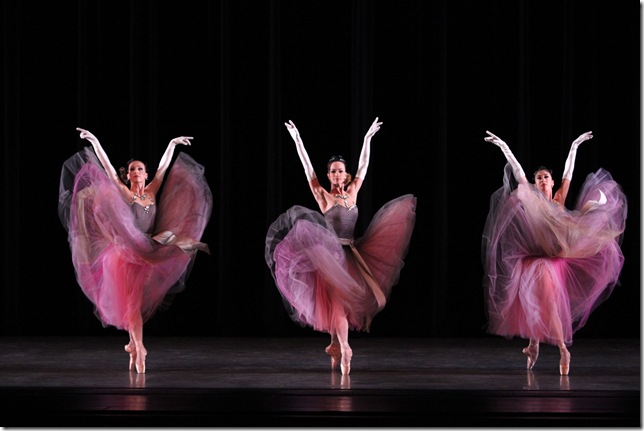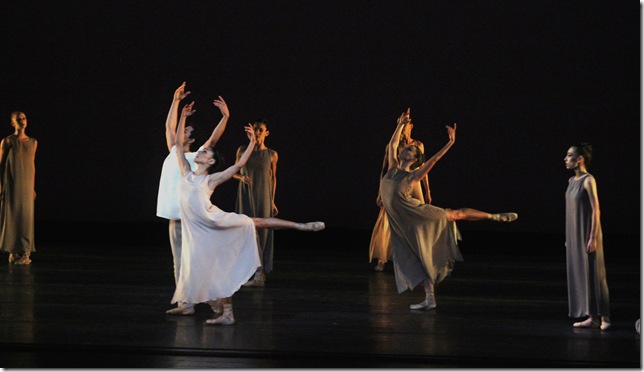By Tara Mitton Catao
For the third program of its current season, seen Saturday night at the Kravis Center, Miami City Ballet has chosen a program of steadfast George Balanchine works and a huge, energy-laden new ensemble creation of Alexei Ratmansky, a new master of the ballet vocabulary.
Two large ensemble pieces sandwiched two traditional Balanchine duets. The first ensemble work choreographed by Balanchine in 1951 was an enormous contrast to the last, choreographed last year by Ratmansky. For a Balanchine work, La Valse is somewhat movement-barren while Ratmansky’s Symphonic Dances is super-filled with movement.
La Valse, a seemingly typical Balanchine work, was strangely devoid of his trademark, intricate movement steps. There were large quadrilles of formations created with just running steps accented with lots of swooning dips. When the dancers finally faced each other and waltzed, it was rewarding moment. An opening trio of women, though a bit ragged, set the mood in long white gloves and long tulle skirts.
The central duet between Tricia Albertson and Carlos Miguel Guerra was mostly gestural and quite minimalistic, so much so that when Reyneris Reyes entered, with his powerful presence as Death, it was a welcome influence although a somewhat strange theatrical concept. Theatrical cohesion is not the point of this ballet; it is more about the 34 dancers losing themselves waltzing to the music of Maurice Ravel.
Next up, for a complete changeup, was Balanchine’s The Steadfast Tin Soldier, a duet of Valentine card sweetness with a fairytale story and an old-fashioned backdrop for a set that still manages to retain its simple charm. Jennifer Lauren was the paper-doll ballerina to whom Shimon Ito, the tin soldier, gave his heart. Ito captured the soldier doll’s staccato movement very well with his pliant and razor-sharp technique.
The second Balanchine duet was Tchaikovsky Pas de Deux, and it is all that we love and appreciate in the great master’s choreography. There is a chance to engage in each dancer’s personality, technique and musicality. Although Reyneris Reyes had an off-balance performance, Nathalia Arja shone with her clarity, lightning-quick footwork and pirouettes as well as with her dazzling stage presence. Clearly, this type of movement is her forte.
The final work, which was the most-anticipated part of the program, was Symphonic Dances, created for Miami City Ballet by Alexei Ratmansky to Sergei Rachmaninov’s Symphonic Dances (Op. 45).
A former dancer himself, the 44-year-old Ratmansky was the successful director of the Bolshoi Ballet for awhile but chose to pursue his choreographic career by coming to the United States. Since then, he has been dubbed the new master of ballet choreography, and has been spinning off one work after another, to the point that he is now considered the most sought-after choreographer in the field today. Currently, Ratmansky is artist in residence at American Ballet Theatre.
Since his childhood, Ratmansky has been fascinated with the complex and layered music of fellow Russian Rachmaninov, and has created many dances to his scores. Rachmaninov’s vigorous music served once again as a solid launching place for the energetic choreography of Symphonic Dances. For a cast of 23 dancers and performed in three seemingly unrelated sections, a bombardment of kinetic movement and diverse images left one grasping for some kind of relationship.
In hindsight, the first section was serene, with its muted flowing costumes and windswept sky background. Ratmansky’s skillful craftsmanship was evident as layer after layer of dancers shifted and circled forming strong choreographic designs. The men were particularly clean, showing their strong technique and unison work, most notably Kleber Rebello and Renato Penteado moving identically time and time again across the stage.
The second section brought an abrupt shift, with a drastic change in costume and lighting. The dancers were transported from a muted elegance and open space to the contrast of a darker place filled with exaggeration and vibrant color. It was reminiscent of Balanchine’s ballroom, seen earlier, filled with long tulle and courteous men attending their dance partners. The following tumult of dramatic interaction together with the abrupt change of mood made it hard to stop wanting to make connections between this section and the first. But like Balanchine in his La Valse, Ratmansky says this work is story-less.
After an awkwardly long blackout, the confusion of images continued in the third section as the dancers returned in hoodies with back blotches on their backs and a frenetic Arja in a tunic with a strange red mark on her back. In its look and mood, it was very reminiscent of Russian propaganda ballets. It was admirable that the company dancers never failed to deliver in this never-easing tumble of energy-laden choreography. A beautiful and welcome moment, where the focus settled, was when Callie Manning and Yann Trividic came together to dance a sensitive, lovely duet.
Every season, Miami City Ballet reminds us what a young and vibrant company it is and this season, it is the same. There is no doubt that the dancers really flourish artistically in the works of the new choreographers, and that the audience eagerly anticipates the unveiling of the season’s new repertory. Under the helm of its new artistic director Lourdes Lopez, changes are sure to take place, but one hopes that a major focus will continue to be creating new repertory for dancers to shine in and for the audience to enjoy.
The Miami City Ballet’s final performances at the Kravis Center are set for April 5-7. On the program are Dances at a Gathering (Robbins/Chopin) and Slaughter on 10th Avenue (Balanchine/Rodgers). For more information, call 305-929-7010 or visit www.miamicityballet.org.


